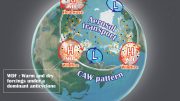
New research warns that deadly heatwaves like the one in Europe in 2003 could become frequent due to climate change, dramatically increasing heat-related mortality rates, particularly in vulnerable regions and populations. The research used advanced climate models to show that even with a 2-degree Celsius global temperature rise, extreme heatwaves that used to occur once in a century could happen every two to five years, putting regions like the U.S. Gulf and Atlantic coasts, Southeast Asia, and the Mediterranean at high risk.
The heatwaves we’re currently facing pose a significant threat to vulnerable groups like the elderly, the sick, and those in financial hardship. The 2003 heatwave serves as a grim reminder of how devastating such events can be. During that time, temperatures in Europe soared to 47.5 degrees Celsius, leading to one of the most catastrophic natural disasters in recent history, with estimated fatalities ranging from 45,000 to 70,000 within just a few weeks.
In addition to the loss of life, the environmental and economic toll was significant. Forests were engulfed in flames, crops dried up in the fields, and urban emergency rooms operated at maximum capacity. Worldwide, the financial damage amounted to approximately 13 billion U.S. dollars. Nevertheless, the public remains less aware of the risks of heatwaves than of other climate-related extremes.
This is a problem, as a study published in the journal Nature Communications points out. Heatwaves like the one we saw in 2003 could become the new norm in the coming years.
Epidemiology and climate modeling combined
Researchers from the Institute for Environmental Decisions at ETH Zurich collaborated with an international group of epidemiologists on the study. Since 2013, they have been systematically collecting data on daily heat-related excess mortality for 748 cities and communities in 47 countries in Europe, Southeast Asia, Latin America, the U.S., and Canada.
The researchers used this dataset to calculate the relationship between the average daily temperature and mortality for all 748 locations. From this, they were able to establish each location’s ideal temperature, where excess mortality is at its lowest. In Bangkok, for example, this value is 30 degrees Celsius, in São Paulo 23, in Paris 21, and in Zurich 18 degrees Celsius.
Physically plausible weather extremes modeled
Every tenth of a degree above this ideal value increases excess mortality. “Not all heat is the same,” explains Samuel Lüthi, lead author of the study and doctoral student under David Bresch, Professor for Weather and Climate Risks. “The same temperature has a completely different impact on heat-related excess mortality in the populations of Athens and Zurich.”
This depends not only on the temperature, but also on physiology (acclimatization), behavior (long siestas in the middle of the day), urban planning (green spaces versus concrete), the demographic structure of the population, and the local healthcare system.
Using this ideal value, the researchers calculated how excess mortality would develop with an average global temperature increase of 0.7 degrees (the value in 2000), 1.2 degrees (the value in 2020), 1.5, and 2 degrees. They used five particularly powerful climate models, known as SMILEs (single-model initial-condition large ensembles).
“We ran the same model up to 84 times, with slightly different weather conditions each round. That gave us a multitude of possible weather systems that are likely to occur if there is a certain amount of CO2 in the atmosphere,” explains Lüthi. The researchers then coupled this data with an epidemiological model to calculate the corresponding heat mortality.
Previous projections of heat-related mortality were mostly based on calculations that used one climate model over a specific period of time.
“Our method allows us to quantify extremes in the climate system much more effectively and reduce uncertainties that arise from the idiosyncrasies of certain models.” Using supercomputers, Lüthi has calculated the impact of over 7,000 years of physically possible weather phenomena on heat-related mortality. The corresponding dataset is more than 1 terabyte in size.
Up to 15 percent of deaths heat-related
The results show that the risk of heatwaves with high excess mortality has already increased dramatically over the past 20 years. “The excess mortality of a hot summer like 2003 used to be considered an extreme, once-in-a-century event. We now expect it to occur once every 10 to 20 years,” says Lüthi, “or, in a world that is 2 degrees warmer, every two to five years in many places.”
Heat mortality figures that were considered highly improbable in 2000 (once every 500 years), will occur 14 times every 100 years in a 2-degree scenario. Assuming no adaptation to the heat, the probability of mortality during such extreme heatwaves will increase by a factor of 69.
Regions that are particularly at risk of escalating heatwaves include the Gulf and Atlantic coasts of the U.S., the Pacific coast of Latin America, the Middle East, Southeast Asia, and the Mediterranean region. Even in moderate climate scenarios, a hot summer in these regions can result in ten percent of all deaths in a country being heat-related. Paris was particularly affected by the heatwave in 2003.
The figure at that time was five to seven percent; that means in the French metropolis alone, the heatwave led to the premature deaths – from dehydration, heatstroke, and heart attack – of around 2,700 people.
“According to our calculations, up to 15 percent of deaths in Paris could be heat-related in the future,” says Lüthi. Europe is amongst the hotspots – particularly southern Europe. There are two factors that come into play here: temperatures here are rising twice as fast as the global mean, and the population is disproportionately older.
A worrying outlook
“The results frightened me,” says the 30-year-old climate scientist. “While I was working on the study, I always tried to look behind the figures and see the real lives of people who are affected by the changes. It’s worrying.”
Particularly, as he points out, because the assumptions underlying the modeling are actually on the conservative side. The study assumes that the global average temperature is on track to increase by a maximum of 1.5 to 2 degrees Celsius, but with greenhouse gas emissions at their current levels, the more likely figure is 2.6 degrees.
And future scenarios do not take into account the projected population growth, migration to cities, and the increase in the number of older people – all factors that are likely to increase heat-related excess mortality even further. The study also lacked epidemiological data for Africa and India, both regions heavily affected by the climate crisis and poverty.
As the researchers state, the results underline the urgency for action. In order to at least curb increasing heat waves, the most important step is to phase out fossil fuels as quickly as possible, Lüthi asserts. The study shows that although the risk is already high at 1.5 degrees, it is still significantly lower than at 2 degrees. However, society can also partly adapt to higher temperatures to reduce the impact of future heat waves. “We should now prepare and manage the unavoidable while avoiding the unmanageable at all costs,” Lüthi recommends.
Reference: “Rapid increase in the risk of heat-related mortality” by Samuel Lüthi, Christopher Fairless, Erich M. Fischer, Noah Scovronick, Ben Armstrong, Micheline De Sousa Zanotti Stagliorio Coelho, Yue Leon Guo, Yuming Guo, Yasushi Honda, Veronika Huber, Jan Kyselý, Eric Lavigne, Dominic Royé, Niilo Ryti, Susana Silva, Aleš Urban, Antonio Gasparrini, David N. Bresch and Ana M. Vicedo-Cabrera, 24 August 2023, Nature Communications.
DOI: 10.1038/s41467-023-40599-x








The climate researchers are busy today on SciTechDaily, and this one is really amusing.
This study worries that a heatwave of a magnitude like 2003 may “occur every 10 to 20 years…or 2 to 5 years in many places”. No, it’s been 20 years, relax already. ““The results frightened me,” says the 30-year-old climate scientist (Samuel Lüthi)”, well of course, Sam was only ten. Setting the ideal climate for cities around the world is arrogant when it differs from the actual climate of the cities, and has some cities’ ideal at nearly double the degrees celsius, as if the cities are in the wrong places and more people move there because they’re idiots who can’t make temperature-related choices. The fundamental arrogance is in the irony that more people die of cold. I’ll cite “Cold-weather accounts for almost all temperature-related deaths” in ScienceDaily based on “Clinical outcomes of temperature related injuries treated in the hospital setting, 2011–2018. Environmental Research, 2020”. More heatwaves so more heat-related deaths, sure, but if I accept the conclusions of this article, higher temperatures would also prevent almost all temperature-related deaths. Even on this article’s own terms and all its conclusions taken on faith at face value, its goals are misanthropic; maybe that’s what’s “Frightening”. As this article says, heat can be adapted to, but cold is a much harder problem.
Oh, and right, the burning Earth AI cartoon thing at the top. Of course the Earth is on fire there, since it’s falling through the thick atmosphere of a gas giant planet. I assume that’s Jupiter? Unless space has a cloudy atmosphere now. Either way the climate would be the least of any inhabitant’s worries. The Earth looks like a hand-drawn model off the original Star Trek show, from before we knew what Earth looked like. I hope SciTechDaily isn’t paying any fees for that. These little cartoons are getting dumber, but at least it’s a good warning about the article’s content.
“Every tenth of a degree above this ideal value increases excess [heat] mortality.”
Why is there no mention of the fact that more people die from extreme cold than from extreme heat? Because the theory behind anthropogenic global warming predicts that global temperatures should rise faster at night and in the Winter, an increase in the global average should reduce the cold deaths. It seems to me that the optimal average temperature should be about where the heat and cold deaths are equal.
These kinds of scare articles about existential threats are based on claims of “could or might.” I’d pay a lot more attention if their authors would put their reputations on the line and say that it “will” happen, or that there is a 95% probability of it happening by a date that the author can expect to still be living. Science is based on numbers, not ‘weasel words.’ Weasel words are the domain of politicians.
The following image, showing the US Heat Wave Index, could formerly be found on the EPA website; it has recently been removed in favor of a difficult to interpret graph that nevertheless shows a politically acceptable upward trend:
https://b1885182.smushcdn.com/1885182/wp-content/uploads/2019/09/clip_image002-1.jpg?lossy=1&strip=1&webp=1
For a different take on the claim of heat waves becoming more frequent in the future, I suggest reading this: https://wattsupwiththat.com/2019/09/06/the-gestalt-of-heat-waves/